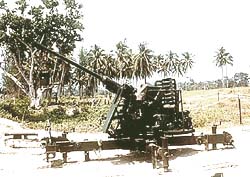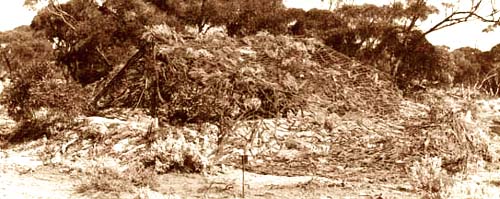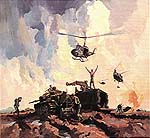Quick Release Camouflage Nets

Bristol Bofors 40mm Light Anti-Aircraft Gun

A photo from 1964 showing a 40mm Bofors deployed on a beach in Malaysia during Confrontation
See 111 LAA Bty RAA website
AB Bofors began as a steel maker in Sweden in the 17th century and commenced manufacturing weapons in the late 1800s. During and after WW1, in cooperation with the German manufacturer, Krupps, they began the design and manufacture of large calibre weapons up to a 12inch naval gun
During the 1920s they were contracted by the Swedish Navy to develop a heavy automatic machine gun to counter aircraft attacks on their ships. This resulted in the release of the Bofors Light Anti Aircraft in 1932.With a mobile field mounting, the gun was popular with armies throughout the world. It was exported in large numbers and manufacturing licenses were purchased by a number of countries, including Britain.
The Bristol Company reworked the gun dimensioning it to imperial measurements and redesigned the ammunition fusing. This was the Bristol Bofors Mk4. By WW2 the Mark 10 was in service, more or less based on the Bofors L60. After the war the Bristol Bofors Mark12 came into service. With electrically powered elevation and traverse, it was controlled by a joystick and aimed by a gyro stablised computing site.
In the 1950s, Bofors released the L70 with a longer barrel and firing a larger cartridge the muzzle velocity was 1020 metres per second. An redesigned firing mechanism raised the rate of fire to 204-300 rpm
The Bristol version of the L70 came into service in 1953 and was eventually replaced by Rapier in the 1980s
Highly developed, the weapon is still in production and service with a number of navies and coast-guards.
Camouflage nets and 40mm Bofor Anti Aircraft Guns usually don't mix. There are too many bits and pieces sticking up off the guns that easily catch the nets and make it hard to get rid of the net, so the gun can get into action.
The practice, using WWII cam nets, was to drape the complete net over the gun, it's platform, the stores required to keep the gun in action as well as spare ammunition. The net was then pushed up from the inside using poles cut from the surrounding bush, if there were any. Finally tent pegs were used to secure the net edges.
When the gun was to go into action the tent pegs from one side were removed and the gunners grabbed the poles and heaved the whole thing in one direction, trying to clear the gun. It didn't always work.
The other problem was that the gun needed to traverse 360 degrees and sometimes this was impeded by the mess of the cam net and poles bunched on the ground.
The gunners for years complained to the Battery Captains. The DRA got into the picture and had the problem researched. The solution adopted was to use lightweight aluminium telescopic poles along with a much finer net that was christened the Barracuda Net. These nets, still in one piece, were covered in the old type scram.
Unfortunately the problem still existed. The only difference was the gunners now had poles that they could carry with them.
In 1967 I was posted to the 111 LAA Bty RAA as OC LAD and saw the problem the gunner crews were having.
After discussions with the gun crews we came up with a prototype consisting of a cam net divided into two and laced to two frames made from ¾ water pipe fitted with a quick release pin to connect the frames together at the top.
This was erected by placing a frame on each side of the gun, angling the frames up with the apex over the center-line where they were locked with the quick release pin. The whole assemble was held in tension by securing bungy cords to various parts of the scrim net, that in turn were held in place by surrounding vegetation or simply pegged into the ground. The base of the frames was secured to the ground with sandbags or pegs.
The outline of the frame was broken up with scrim and the use of the ground cover and its surrounding vegetation.

.. Camouflage nets on quick release framing in place over a Bristol Bofors Mk12 ..
The gun was re-camouflaged simply by bringing the two frames together again replacing the securing pin.
The invention was user trailed over nine months both at Cultana SA and Darwin in the NT. RAAF personnel informed me that they couldn't detect the guns from the air. The gunners of 111 LAA Bty thought they were great as they worked and they didn't have to untangle the nets from the gun any more and of course they were easily reset.


